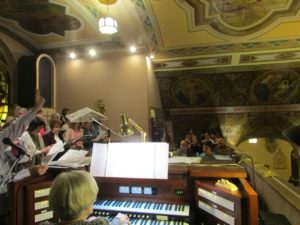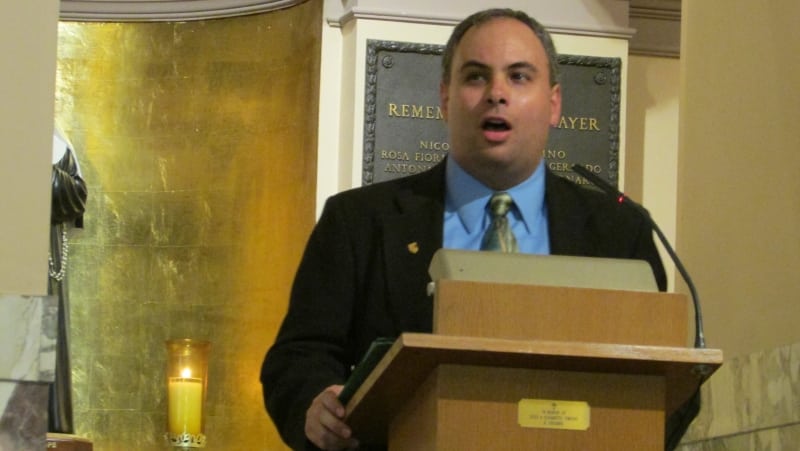The word “liturgy” is from the Greek language and it originally referred to a public gathering of the whole community in which something vital was done for all the people. It is therefore often said today that it means “the work of the people.” When done in a way that engages the gifts of its members, the celebration of the Vigil of Easter can be one of the most beautiful liturgical enactments in that sense. Besides often requiring many liturgical ministers, the liturgy, as it is celebrated in the Catholic Church, often includes the final initiation of the elect into the church through baptism, confirmation and Eucharist – the three sacraments of initiation, performed together and in that order according to the pattern established in the first and second centuries.
The Vigil of Easter also invites singing ranging from the ancient chant of the Easter Proclamation (or Exsultet in Latin, based on the first line “Let the powers of heaven exult!”) to psalms, baptismal songs, and acclamations proclaiming new life.
Saint Mary of Mount Carmel / Blessed Sacrament Parish in Utica, New York not only draws out almost every one of its many liturgical ministers for some function in the celebration of its Easter Vigil, but does so in an engaging and vibrant enactment of its spectacle, while never placing the assembly in the role of spectators. The Vigil in this parish community is not a “play” enacted for others to see but a dynamic living of the unsurpassable joy this feast represents. While this liturgy – and indeed all the liturgies of the Sacred Days of Easter – include many elements of drama there is no doubt as to the why and the Who behind this celebration. For though this enactment is the work of the people, the one who acts through this liturgy is the risen Christ, present in his people and his ministers.
The rubrics from the Roman Missal, drawing upon a Scriptural analogy (Luke 12:35-37), specify that those who gather on this night should be “like those looking for the Lord when he returns, so that at his coming he may find them awake.” Like Good Friday before it, people gather in darkness, but do not need to do so in absolute silence. The music and reflection begin at Mount Carmel over a half-hour before the actual liturgy, complete with spiritual readings, a welcome of people and a short guide to the entire service, and vibrant songs including a rousing rendition of the African American spiritual, “Over my head, I hear music in the air … there must be a God somewhere!” Those who gather know the reason for which they come.
Silence does come as the celebration begins, with a blessing of a “blazing fire” (though indoors due to upstate New York’s notoriously changeable weather in early spring) that remains visible as the church stays in darkness throughout the reading of the Word from the Hebrew Scriptures. A procession with the candle which lights the church as candles are lit and the Exsultet sung, praising the grace and love of God who conquers death based on the tune of Roc O’Conner’s “Lift Up Your Hearts,” which becomes with the Exsultet text, “Behold the Glory of God.”
A dramatic reading of Genesis with slides of all of creation create a mood of awe. Dancers proclaim with their marvelous movement the refrain repeated throughout the night from David Haas’ composition “Everything will live where the river flows!” The story of Abraham is proclaimed with Bob Hurd’s setting of Psalm 25, “To You, O God, I Life Up My Soul,” excerpted below with dance.
The most dramatic enactments are saved, as is appropriate, for the central Exodus reading of the deliverance of the Israelites – refugees from the empire of Egypt – at the Red Sea. Complete with waving blue fabric representing the water, dancers pass through as the assembly sings Marty Haugen’s “I Will Walk in the Presence of God,” followed by another African transliterated hymn “We Are Marching in the Light of God.” The readings from the Hebrew Scriptures conclude as multiple parts of several readings are condensed and combined into the readings about Holy Wisdom, as the Book of Gospels is brought forward for proclamation in a short time and the refrain of Michael Joncas’ “I Have Loved You,” reminds everyone of the tender and tenacious love of God.
Even after the lights come on with the resplendent Gloria, the beauty of this liturgy unfolds in the rite of baptism and confirmation of those seeking it after completing a process known as the Rite of Christian Initiation of Adults (RCIA) which includes learning about the teaching of the Catholic church but also learning how to be Catholic in one’s whole life. Baptism and Confirmation mark the dying and rising with Christ for the newly initiated, and their sealing with the Holy Spirit.
However, before those rites, the entire community prays that the saints of all time may be present and bless those seeking baptism and the rest of the assembly, who renews their baptismal commitment on this holy night. Below is a dramatic water rite that includes water being collected from all across the church and poured into the bowl near the Easter Candle. There it will be blessed as the fount of living water where the elect will be baptized and from which all members of assembly will renew their baptisms. The water is collected as the Litany of Saints (setting (adapted) by John Becker) is sung – a reminder that the water that flows so that we might live is both literal and metaphorical (we are surrounded by the cloud of witnesses – the saints – who inspire us and call us to be true Christians in charity and justice for all):
After this, the liturgy continues with a festive celebration of the Eucharist where we are nourished again at the table of the Lord, reminded of the disciples of Emmaus who knew him again in “the breaking of bread.”
With so many people who make this liturgy happen the way that it does each year, it is a reminder to me that while I also bring gifts to such a celebration – theological, liturgical, logistical – I am only one of the many gifted people who make this celebration possible. I remain in awe of the “work of the people” and of the risen Christ who works through them.
I’ll conclude with a small example of this by the below image of the choir from the Vigil in the choir loft at Mount Carmel. There is no room to stand as the space for singers and the space for instrumentalists (including multiple flutes, a brass section, two drummers, three guitarists, a piano player and organ) is completely full with ministers of music who are not paid for what they do but whose spiritual depth never ceases to fill me with awe.




 Request Dr. DelMonico's professional services for a liturgical, ministerial or leadership consultation, or for an academic or public presentation.
Request Dr. DelMonico's professional services for a liturgical, ministerial or leadership consultation, or for an academic or public presentation.